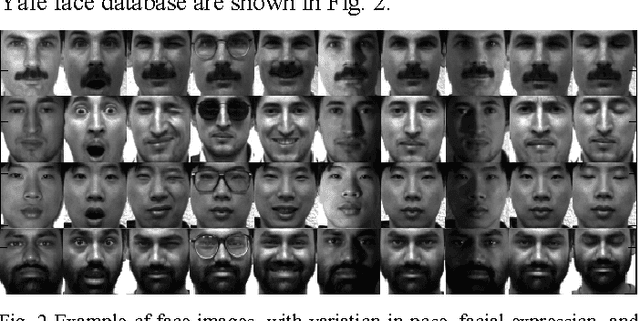Reza Ebrahimpour
Cueless EEG imagined speech for subject identification: dataset and benchmarks
Jan 16, 2025Abstract:Electroencephalogram (EEG) signals have emerged as a promising modality for biometric identification. While previous studies have explored the use of imagined speech with semantically meaningful words for subject identification, most have relied on additional visual or auditory cues. In this study, we introduce a cueless EEG-based imagined speech paradigm, where subjects imagine the pronunciation of semantically meaningful words without any external cues. This innovative approach addresses the limitations of prior methods by requiring subjects to select and imagine words from a predefined list naturally. The dataset comprises over 4,350 trials from 11 subjects across five sessions. We assess a variety of classification methods, including traditional machine learning techniques such as Support Vector Machines (SVM) and XGBoost, as well as time-series foundation models and deep learning architectures specifically designed for EEG classification, such as EEG Conformer and Shallow ConvNet. A session-based hold-out validation strategy was employed to ensure reliable evaluation and prevent data leakage. Our results demonstrate outstanding classification accuracy, reaching 97.93%. These findings highlight the potential of cueless EEG paradigms for secure and reliable subject identification in real-world applications, such as brain-computer interfaces (BCIs).
Age Effects on Decision-Making, Drift Diffusion Model
Nov 30, 2023



Abstract:Training can improve human decision-making performance. After several training sessions, a person can quickly and accurately complete a task. However, decision-making is always a trade-off between accuracy and response time. Factors such as age and drug abuse can affect the decision-making process. This study examines how training can improve the performance of different age groups in completing a random dot motion (RDM) task. The participants are divided into two groups: old and young. They undergo a three-phase training and then repeat the same RDM task. The hierarchical drift-diffusion model analyzes the subjects' responses and determines how the model's parameters change after training for both age groups. The results show that after training, the participants were able to accumulate sensory information faster, and the model drift rate increased. However, their decision boundary decreased as they became more confident and had a lower decision-making threshold. Additionally, the old group had a higher boundary and lower drift rate in both pre and post-training, and there was less difference between the two group parameters after training.
A specialized face-processing network consistent with the representational geometry of monkey face patches
Oct 30, 2016



Abstract:Ample evidence suggests that face processing in human and non-human primates is performed differently compared with other objects. Converging reports, both physiologically and psychophysically, indicate that faces are processed in specialized neural networks in the brain -i.e. face patches in monkeys and the fusiform face area (FFA) in humans. We are all expert face-processing agents, and able to identify very subtle differences within the category of faces, despite substantial visual and featural similarities. Identification is performed rapidly and accurately after viewing a whole face, while significantly drops if some of the face configurations (e.g. inversion, misalignment) are manipulated or if partial views of faces are shown due to occlusion. This refers to a hotly-debated, yet highly-supported concept, known as holistic face processing. We built a hierarchical computational model of face-processing based on evidence from recent neuronal and behavioural studies on faces processing in primates. Representational geometries of the last three layers of the model have characteristics similar to those observed in monkey face patches (posterior, middle and anterior patches). Furthermore, several face-processing-related phenomena reported in the literature automatically emerge as properties of this model. The representations are evolved through several computational layers, using biologically plausible learning rules. The model satisfies face inversion effect, composite face effect, other race effect, view and identity selectivity, and canonical face views. To our knowledge, no models have so far been proposed with this performance and agreement with biological data.
ECOC-Based Training of Neural Networks for Face Recognition
Dec 14, 2013

Abstract:Error Correcting Output Codes, ECOC, is an output representation method capable of discovering some of the errors produced in classification tasks. This paper describes the application of ECOC to the training of feed forward neural networks, FFNN, for improving the overall accuracy of classification systems. Indeed, to improve the generalization of FFNN classifiers, this paper proposes an ECOC-Based training method for Neural Networks that use ECOC as the output representation, and adopts the traditional Back-Propagation algorithm, BP, to adjust weights of the network. Experimental results for face recognition problem on Yale database demonstrate the effectiveness of our method. With a rejection scheme defined by a simple robustness rate, high reliability is achieved in this application.
 Add to Chrome
Add to Chrome Add to Firefox
Add to Firefox Add to Edge
Add to Edge